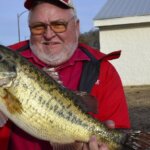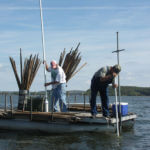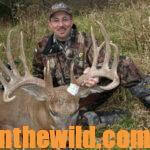Editor’s Note: In late spring and summer, you can catch crappie in many unorthodox ways, including fishing with knitting thread, fake hair or fur, jugging, goldfish, chumming and egging to name a few tactics. This week we’ll look at fishing strategies you can use for crappie that you’ve probably never considered.
 I never met a crappie-fishing angler like my friend, Skeeter Skelton, who could catch crappie when no else could. He employed a technique that you’d have to see to believe. When I first fished with Skelton about three decades ago and asked him if we would fish for crappie with minnows or jigs, he answered, “No, knitting thread.” When I asked what Skelton meant, he replied, “Knitting thread is what we’re going to use to fish for crappie.” If you’re confused, think about me as I tried to make a decision about whether to carry a cane pole, a bait-casting outfit, a spinning rod or some other type of tackle to fish with knitting thread. But I learned the wisdom of Skelton’s crappie-catching technique that first day when he and I fished together.
I never met a crappie-fishing angler like my friend, Skeeter Skelton, who could catch crappie when no else could. He employed a technique that you’d have to see to believe. When I first fished with Skelton about three decades ago and asked him if we would fish for crappie with minnows or jigs, he answered, “No, knitting thread.” When I asked what Skelton meant, he replied, “Knitting thread is what we’re going to use to fish for crappie.” If you’re confused, think about me as I tried to make a decision about whether to carry a cane pole, a bait-casting outfit, a spinning rod or some other type of tackle to fish with knitting thread. But I learned the wisdom of Skelton’s crappie-catching technique that first day when he and I fished together.
Skelton always searched for what he called hidden trees. “Look for stumps on the banks where a tree once was, broken-off trees lay and/or holes are where the tree roots were blown down by a mighty wind. From the holes and the stumps, you should be able to guess about how big the tree was. Then figure out approximately where the top of that tree would be if it fell into the lake.” Skelton fished successfully for crappie in the days before the widespread use of the depth finder by identifying invisible trees. Once Skelton determined the approximate position of the tree top in the water, he then pulled out a variety of his homemade knitting thread jigs.
“Those store-bought jigs are so expensive that I’ll go broke buying them,” Skelton told me. “I’ve bought a split-shot lead mold from a catalog. I pour up 1/8-, 1/4- and 1/2-ounce split shot from the lead I pick up around town. Next I get some wire crappie hooks and several different-colored skeins of knitting thread. I cut the knitting thread into various lengths, put three strands of knitting thread and the hook in a shot lead and crimp the shot lead closed. I now have a knitting-thread jig, and if I lose it, I’ve only lost pennies.”
 Skelton needed to fish only with inexpensive jigs, since he generally would fish 15 to 20 treetops each morning and the same number in the afternoon. “Crappie will be in one of those tree tops,” Skelton explained. “All I’ve got to do is find out which tree top they’re in, and then once I start catching them, I just change out the color of my knitting thread until I take a good mess of crappie from the same tree top.”
Skelton needed to fish only with inexpensive jigs, since he generally would fish 15 to 20 treetops each morning and the same number in the afternoon. “Crappie will be in one of those tree tops,” Skelton explained. “All I’ve got to do is find out which tree top they’re in, and then once I start catching them, I just change out the color of my knitting thread until I take a good mess of crappie from the same tree top.”
Every time I got hung-up in a tree limb, Skelton would tell me to, “Break it off. It’s just knitting thread. I’ve got plenty more. If we run out of our knitting-thread jigs, I’ve got the makings for thousands more right here in the boat. If we each don’t break off 50-75 jigs each in a day, we’re not fishing where the crappie are.”
 On that day with Skelton, he and I caught a total of more than 100 crappie, but only kept the ones 1-1/2-pounds or better. We filled-up two coolers, his and mine. Even today when I crappie fish for a day, I always carry some wire hooks, split shots and one or two skeins of knitting thread with me. Then I’m prepared if I run out of my expensive crappie baits.
On that day with Skelton, he and I caught a total of more than 100 crappie, but only kept the ones 1-1/2-pounds or better. We filled-up two coolers, his and mine. Even today when I crappie fish for a day, I always carry some wire hooks, split shots and one or two skeins of knitting thread with me. Then I’m prepared if I run out of my expensive crappie baits.
To learn much more about crappie fishing, get John E. Phillips’ Kindle eBooks, and print and Audible books by going to https://johninthewild.com/books/#crappie or to www.barnesandnoble.com.
To receive and download for free “The Crappie Catchers’ Cookbook,” by John and Denise Phillips, go to https://johninthewild.com/free-books.










